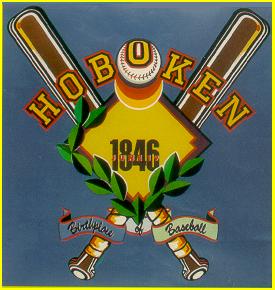 |
 Hoboken and the Beginnings of Baseball
Hoboken and the Beginnings of Baseball
By Nicholas Acocella
Part 5b - The Doubleday Myth (2)
The truth did not emerge until the late 1930s, after baseball officialdom had decided to locate its Hall of Fame in Cooperstown. In the midst of preparations for the "centennial" of Doubleday's spontaneous domestic creation, to be marked by the opening of the Hall of Fame, a librarian name Robert W. Henderson published several papers in which he cited 19th century books about sports to prove conclusively that baseball had indeed evolved from rounders. At about the same time, Bruce Cartwright, a grandson of the old Knickerbocker, produced diaries detailing his ancestor's role in baseball's origins. This combination of events sent the baseball hierarchy and Cooperstown's city fathers into a tizzy. They resolved their dilemma by going ahead with their plans for 1939, but paradoxically electing Cartwright a member of the misplaced Hall of Fame in 1938. The most that can be said for the inscription on his plaque is that it is at least more accurate than the Mills Report:
Alexander Joy Cartwright, Jr.
"Father of Modern Baseball"
Set Bases 90 Feet Apart.
Established 9 Innings as a Game
and 9 Players as a Team, Organized
The Knickerbocker Baseball Club
of N.Y. in 1845. Carried Baseball
to Pacific Coast and Hawaii
in Pioneer Days.
No one any longer takes seriously the official fable, although the Hall of Fame still possesses a dilapidated old ball that Graves's son found in a trunk and that was once celebrated as the one that Doubleday used in his ur-game. Even Thomas R. Heitz, the Librarian at the National Baseball Library and Archive from 1983 to 1994, a branch of the Hall of Fame, concludes in an entry on the "Rules and Scoring" he co-authored for Total Baseball, that "some basic baseball principles can be traced back for centuries" and that "the codified Knickerbocker rules serve as a direct link to the rules of today." (He nowhere mentions either Alexander Cartwright or the City of Hoboken in his essay, however.) Organized baseball's approach to the matter had vacillated between gingerly and wistful. Heitz has even come up with a second Abner Doubleday, a cousin of the future general. This Abner Doubleday lived in Cooperstown in 1839, and Graves probably confused him with his more famous relative. Whether this other Doubleday was given to drawing diagrams of games with a stick is immaterial; the game Graves describes, absent the embellishments of the Mills Report, is still town ball or rounders, with the number of participants limited for reasons of safety. For the most part, though, baseball officialdom's commitment to Cooperstown comes with a wink, as, if to say, "If baseball wasn't born here, it should have been.".



|
|
 |